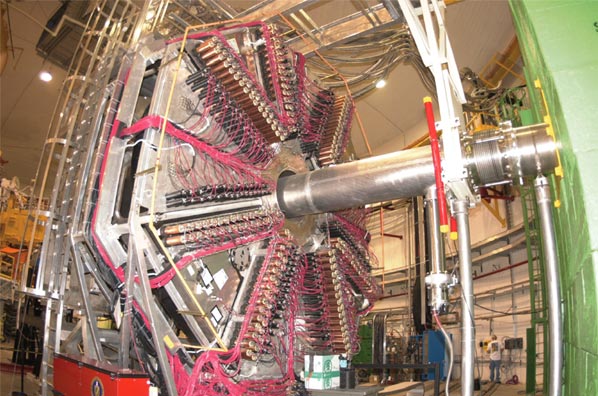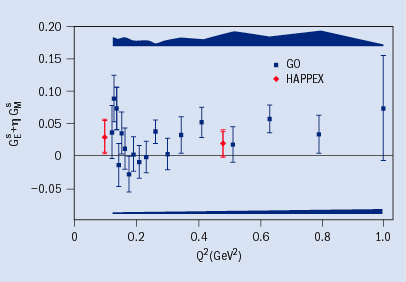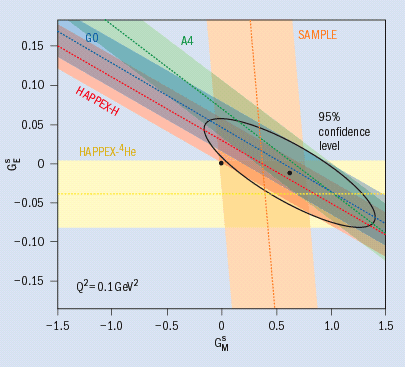Several research groups are conducting experiments to determine the exact contributions of strange quarks in the quark-gluon “sea” to the proton’s charge distribution and magnetization.
A simple understanding of the proton is that it is an object composed of three quarks. However, the rich structure predicted by the theory of quantum chromodynamics (QCD) indicates that this picture is incomplete. A sea of gluons and virtual quark/anti-quark pairs is also present, and this plays an important role, for instance, in accounting for the proton’s total spin contributes to other properties of the nucleon. Their specific goal is to determine the exact contributions of the sea’s strange quarks to the proton’s charge distribution and magnetization. Four major experimental collaborations have weighed in, and their results are beginning to paint a cohesive picture of strange quarks in the proton.

The contribution of the strange quark to these properties is the easiest to pinpoint, because the strange quark is the most accessible of all the sea’s constituents. Up and down quarks are the most likely quarks to be present in the sea, because they are the lightest. However, they have the same quantum numbers as the valence quarks, so it is nearly impossible to disentangle their contributions. Strange quarks are the second lightest, so are likely to be the second most significant part of the quark-gluon sea.

Parity-violating electron scattering offers a promising method of accessing the strange quarks. These experiments study collisions between a beam of polarized electrons and target particles. Specifically, they measure the interference of the electromagnetic interaction, in which a photon is exchanged, and the neutral weak interaction, which involves the exchange of a Z0 boson. The electrons are polarized, meaning that they are spinning either along their direction of travel (right-handed) or opposite to it (left-handed). This allows the class of electroweak
interactions to be separated into the electromagnetic and weak components.

The electromagnetic force is parity-conserving, or mirror-symmetric, so the electron’s handedness does not affect scattering rates. The weak force, however, is not mirror-symmetric: it is parity-violating. Therefore, owing to the neutral weak force, a different number of scattering events will be observed when the beam of electrons is right-handed compared with left-handed. A comparison of the weak and electromagnetic pieces allows the experimenters to disentangle the contribution of the up, down and strange quarks.
Meeting the challenge
The experimental challenge arises because the electromagnetic force is much stronger than the weak force, so many scattering events must be recorded to measure the tiny difference, or asymmetry, in scattering rates. In addition, careful attention has to be paid to the possibility of false asymmetries masquerading as the true asymmetry due to the weak force. These can arise, for example, if the beam position or angle on the target changes when the polarized beam is changed from right- to left-handed and vice versa. Typical requirements for these experiments are that these changes must be less than a few nanometres and nanoradians, respectively. Ensuring this stability demands close collaboration between the experimenters and the accelerator physicists and operators, and precise monitoring of the electron-beam characteristics from the source, through the accelerator, and to the experimental hall.
Four research programmes have adopted parity-violating electron scattering to search for the contributions of strange quarks to proton structure. They are the SAMPLE experiment at the MIT-Bates Linear Accelerator Center, the A4 experiment at the Mainz Microtron, and the G0 (G-zero) experiment and Hall A Proton Parity Experiment (HAPPEX) at the US Department of Energy’s Jefferson Lab. The various experiments are sensitive to different combinations of strange-quark contributions to the charge distribution and magnetization. These are represented by GsE and GsM, the strange electric and magnetic form factors, respectively. Experiments using a hydrogen target and a forward scattering angle, including G0, A4 and HAPPEX-H (HAPPEX on hydrogen), all measure a linear combination of GsE and GsE and GsM (the exact combinations differ for each experiment). Disentangling the two form factors requires measurements at both forward and backward angles or with a different target (e.g. helium).
The SAMPLE experiment at MIT-Bates, which is now complete, measured backward-angle electron scattering from hydrogen and deuterium targets at 200 MeV. Cherenkov light produced by electrons scattered with a momentum transfer, Q2, near 0.1 GeV2 was focused by an array of mirrors onto a set of 8 inch photomultiplier tubes. The researchers concentrated in particular on obtaining GsM, the strange quark’s contribution to the proton’s magnetic moment (Ito et al. 2004 and Spayde et al. 2004).
Researchers with the A4 experiment at Mainz use a new type of total absorption calorimeter, making use of 1022 very fast individual crystals of lead fluoride to detect scattered electrons, plus sophisticated read-out electronics. They have measured forward-angle (35°) electron scattering from hydrogen at two values of Q2, 0.23 and 0.11 GeV2 (Maas et al. 2004 and 2005).
The G0 and HAPPEX experiments at Jefferson Lab took advantage of the high-quality polarized electron beam from the Continuous Electron Beam Accelerator Facility (CEBAF). They have taken data with a 3 GeV beam with up to 86% polarization.
G0 required a unique beam pulse structure and a custom-built spectrometer package capable of measuring over large solid angles. The G0 spectrometer, based on a toroidal superconducting magnet, measures elastically scattered recoil protons over a wide range of forward-scattering angles (and thus a large range of Q2) simultaneously (Armstrong et al. 2005). A time-of-flight technique for identifying the scattered protons required the use of a pulsed beam, with electron bunches arriving every 32 ns. With this pulse structure, the 40 μA electron beam had a large instantaneous current equivalent to 640 μA, providing challenges for the accelerator.
HAPPEX used a pair of high-resolution, small-acceptance spectrometers to measure precisely forward-angle scattering at a single momentum transfer at a time. Initial measurements were made at Q2 = 0.48 GeV2 with a hydrogen target, and recently data were taken at Q2 = 0.1 GeV2 using both hydrogen and 4He targets (Aniol et al. 2004 and 2005). The hydrogen target allowed the HAPPEX researchers to measure the strange quark’s contribution to a combination of the charge and magnetization distributions in the proton. 4He is a nucleus with no net spin, so the helium target allowed them to isolate the strange electric form factor of the proton.
The results from all of these experiments present a cohesive picture of the strange quark’s contribution to the charge distribution and magnetization. All are consistent with this contribution being non-zero in the proton.
Figure 1 on p30 shows the G0 and HAPPEX results from hydrogen target data as a function of Q2. The measured combination of the strange form factors GsE and η GsM (η is a kinematic factor) appears to be non-zero, and an intriguing and unexpected dependence on momentum transfer is suggested by the data. At the lowest Q2 measured so far (0.1 GeV2), all four experiments provide information about different combinations of GsE and GsM, as depicted in figure 2. The results favour a positive value for GsM, suggesting that the strange quarks reduce the proton’s magnetic moment. A negative value for GsE, while only hinted at by the data, would imply that the strange quarks prefer to be on the outside of the proton, while the anti-strange quarks favour the interior. However, current experiments are not precise enough for us to state definitively that the strange quark contributions are non-zero.
Within QCD-inspired models, predictions of the strangeness form factors vary tremendously. Of course, the models are of less interest than the predictions of nonperturbative QCD itself, for which our most reliable tool is lattice QCD. In this direction, there has been remarkable progress with a very precise recent determination of the strangeness magnetic moment (GsM = −0.046 ± 0.019 μN), yielding an answer with an uncertainty of better than 1% of the proton’s magnetic moment (Leinweber et. al. 2005). Testing this prediction will push the upcoming measurements to the limits of their precision.
Meanwhile, the experiments continue. HAPPEX is taking data this autumn, and the collaboration expects to reduce the error bars by a factor of three for both targets. Both the G0 and A4 collaborations have turned their detectors around by 180° and will soon measure backward-scattered electrons at various values of Q2, which will be primarily sensitive to GsM. Combining forward- and backward-scattering results will allow both GsM and GsE to be individually determined. These additional measurements will allow experimenters to obtain GsE and GsM over a range of momentum transfers and thus pin down the importance of the contributions of the strange sea to the structure of the proton.
Further reading
K A Aniol et al. 2004 Phys. Rev. C 69 065501.
K A Aniol et al. 2005 http://arxiv.org/abs/nucl-ex/0506010 and http://arxiv.org/abs/nucl-ex/0506011
D S Armstrong et al. 2005 Phys. Rev. Lett. 95 092001.
T M Ito et al. 2004 Phys. Rev. Lett. 92 102003.
D Leinweber et al. 2005 Phys. Rev. Lett. 94 212001.
F E Maas et al. 2004 Phys. Rev. Lett. 93 022002.
F E Maas et al. 2005 Phys. Rev. Lett. 94 152001.
D T Spayde et al. 2004 Phys. Lett. B 583 79.








